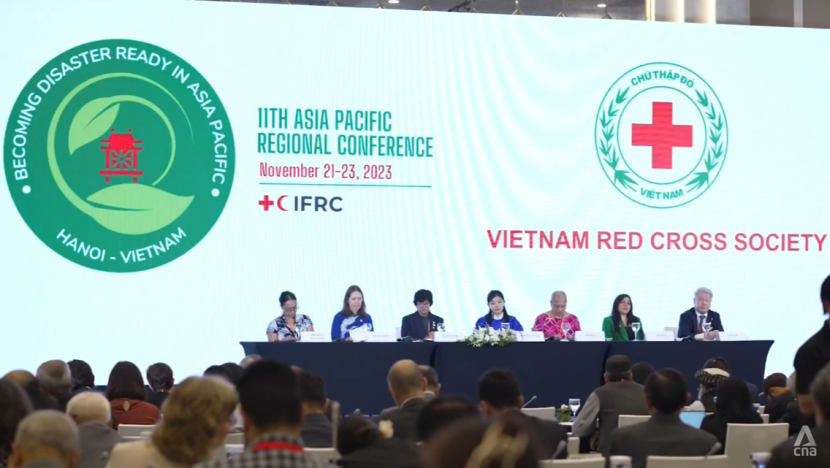IFRC wraps up Hanoi meeting with calls for better disaster preparedness in Asia Pacific
This year’s meeting was also dominated by a man-made crisis – the Israel-Hamas war.

Delegates attend the International Federation of Red Cross and Red Crescent Societies (IFRC) 11th Asia Pacific Regional Conference in Hanoi, Vietnam.

This audio is generated by an AI tool.
HANOI: The world's largest humanitarian network wrapped up a crucial regional meeting in Hanoi this week, with a call for better disaster preparedness in the Asia Pacific amid accelerating climate risks.
The conference, held once every four years by the International Federation of Red Cross and Red Crescent Societies (IFRC), discusses the impact of natural disasters in the region.
But this year, the Nov 21-23 meeting in Vietnam’s capital was also dominated by a man-made crisis – the Israel-Hamas war.
“The number of crises that we face are largely going to be triggered by extreme weather events and climate risks,” said Mr Alexander Matheou, the IFRC’s regional director for Asia Pacific.
“But it's the man-made crises that are often the most traumatic and the hardest ones to respond to.”
ISRAEL-HAMAS WAR
The Israel-Hamas conflict, into its seventh week, has displaced more than 1.7 million people in the Gaza Strip, according to the United Nations’ children’s agency UNICEF.
Multiple aid organisations, including the IFRC, have renewed calls for an extended humanitarian ceasefire and pleaded for desperately needed aid to be allowed unimpeded into the devastated enclave.
“(We) express deep concern about the protracted crisis in the Middle East and express solidarity with Palestinian Red Crescent Society and Magen David Adom,” said Tunku Puteri Intan Safinaz, chairwoman of the Malaysian Red Crescent Society, in a statement at the conclusion of the conference. Magen David Adom is Israel's national emergency medical, disaster, ambulance and blood bank service.
Dr Hossam Elsharkawi, IFRC’s regional director for Middle East and North Africa, also read to delegates the organisation’s recommendations regarding developments in Gaza.
“Endorsing the truce is insufficient. We must actively call for a permanent ceasefire,” he said.
“It is crucial to issue a statement condemning the violations and denouncing atrocities, specifically the deliberate targeting of civilians, medical personnel and hospitals,” he said.
Other recommendations include advocating for additional access points to Gaza, avoiding forcing people to leave their homes in population transfer scenarios, and providing support to the Palestinian Red Crescent.
The aid network said that civilians are paying the “highest price” in the hostilities, and has called on all parties to allow humanitarian organisations to safely access and support those impacted by the crisis.
Delegates said the conflicts in Gaza and Ukraine take away huge amounts of attention and resources from programmes on climate action.
“The biggest challenge is that we have more and more diversified types of humanitarian crises,” said Mr Ma Wenbo, a representative from the Red Cross Society of China.
“We have natural disasters, and we also have man-made ones like war, armed conflicts, etc., which is stretching our resources.”
CLIMATE RISKS
Even as these conflicts divert public attention, the IFRC highlighted the need for the region to guard against growing climate risks.
Delegates at the conference agreed on a call for action for Asia Pacific, which is the world's most disaster-prone area.
Nearly 45 per cent of the world’s natural disasters occur in Asia and the Pacific, and more than 75 per cent of those affected live within the region, according to the UN.
IFRC listed actions such as improvements to early disaster warning systems, and ensuring financial sustainability and transparency.
It also reiterated the need for humanitarian groups to ensure they are ready to respond to emergencies. This means putting in place a pool of trained responders, and logistics to secure aid supplies.
“This includes how we can build on each other's strengths. We need to ensure that national societies are strong,” said Singapore Red Cross Society’s CEO Benjamin William.
“We cannot be dependent on just a few countries to provide the resources. There's more and more awareness that all national societies have to build their resource mobilisation capacity.”
FINANCIAL SUSTAINABILITY
The IFRC said funding is one of the biggest challenges faced by its network of 191 member societies across the globe.
“The international financing for disaster response is reducing. It's also stretched more than ever before, because we're dealing with more crises than ever before,” said Mr Matheou.
Governments are the main donors to the organisation, accounting for more than 80 per cent of its budget in the past five years.
Apart from contributions from traditional big donor countries such as the United States, Germany and Japan, other nations like China and Singapore are also stepping up their game in aid financing in recent years, said the group.
However, these are voluntary contributions and they fluctuate. Growing instances of climate disasters and new additions in the humanitarian space also increase the need for more funding and resources.
“Without increased funding from the public, our current sustainability is at stake, both in the long run and for current operations,” said Dr. Atsushi Seike, president of the Japanese Red Cross Society.
“Without the financial sustainability of the Red Cross (and Red Crescent Societies), many actions such as disaster rescue cannot be carried out.”
Dr Seike also highlighted the ageing population in the region, which is likely to decrease the pool of public donors and volunteers for humanitarian networks.
According to the Asian Development Bank (ADB), one in four people in Asia Pacific will be over 60 years old by 2050.
“We need a new range of government donors to contribute generously to the multilateral system so that we can support each other in times of crisis,” Mr Matheou said.
He added that countries need to boost their disaster preparedness and crisis response capabilities.
“National institutions need to (have the ability to) respond independently, at least to the small- and medium-scale disasters,” he said. “As much self-reliance as possible is an important advance we need to make.”













.jpg?itok=R5pc4Fwr)




